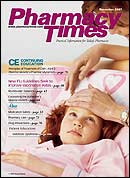Publication
Article
Pharmacy Times
Watch for Blockbuster Generics over Next Year
Author(s):
Leading medications for allergies, heart failure, insomnia, and osteoporosis have recently lost or will soon lose patent protection.
Mr. Lamb is a freelance pharmacywriter living in Virginia Beach,Va, andpresident of Thorough Cursor Inc.
Leading medications for allergies,heart failure, insomnia, and osteoporosishave recently lost or willsoon lose patent protection and facecompetition from lower-cost, equallyeffective products.Among biopharmaceuticals,a widely used human growth hormone,2 coagulation factors, an immunosuppressant,and a major rheumatoidarthritis treatment will also see theirpatents expire in the coming year. The biologicsmay or may not get competitors.
It may seem surprising that severalof the drugs do not have competitorswaiting in the wings, ready to hit pharmacyshelves the day the innovator'spatent expires. In nearly all instances,however, at least one generic drugmaker is currently petitioning the FDAto approve an unbranded version of alisted drug. To take just one example,Mayne Pharma has been seeking federalreview of an Abbreviated NewDrug Application (ANDA) for its versionof irinotecan (Camptosar; Pfizer) sincelate December 2005.4
In other instances, federal courtcases brought years before expectedpatent expiration are still being litigated,holding up the determination of apotential generic product's status.Again citing a single example, NovoNordisk, which holds the patent onrepaglinide and sells the drug underthe brand name Prandin, sued SunPharmaceutical subsidiary Caraco forpatent infringement in 2005 afterCaraco filed an ANDA for repaglinide.The case has been before the courtssince 2005 and is unresolved.5
Biopharmaceuticals require separateconsideration in any discussion ofgeneric drugs because the FDA has noprocess for certifying that 2 protein-basedmedications are similar enoughto be rated as equally safe and effective.The lack of a biogeneric approvalprocess has created a biopharmaceuticalmarket in which patent expirationdoes not make a brand name productsubject to generic competition. In realworldterms, this means that the epoetinalfa product that Amgen sellsunder the brand name Epogen competesonly with the epoetin alfa productthat Ortho Biotech sells under thebrand name Procrit, even though thepatents for both expired in 2004.
Legislation introduced in Congressearlier this year, the Access to Life-Saving Medicine Act (HR 1038), wouldchange this by requiring the FDA tocreate simplified application and reviewprocesses for biologics that arevery similar, if not identical, to existinglicensed products. The legislation andits companion Senate bill were in committeeat press time.
If passed in its current form, HR 1038would allow products to be approvedfor marketing if they could be shown tobe "comparable" in molecular structureand effect to those with existinglicenses without first going throughnumerous clinical trials.6
For a table of blockbuster patent expirations and first-time generics from August2006 to February 2008, and a table of biopharmaceuticals going off patent in2007-2010, please see tables 1 and 2 (PDF).
References
- Express Scripts. Drug Trend Report 2005. Available at: www.express-scripts.com/ourcompany/news/industryreports. Accessed April 4, 2007.
- FDA. Electronic Orange Book. Available at: www.fda.gov/cder/ob. Accessed April 4, 2007.
- Drugs@FDA Web site. Available at: www.accessdata.fda.gov/scripts/cder/drugsatfda. Accessed April 4, 2007.
- Mayne Pharma (USA). December 19, 2005. Correspondence. Available at: www.fda.gov/ohrms/DOCKETS/dockets/05p0496/05p-0496-cp00001-01vol1.pdf. Accessed April 5, 2007.
- Court refuses to dismiss shareholder of defendant from Novo Nordisk case. Pharm Law Industry. 2006;48:3.
- The Access to Life-Saving Medicine Act. February 14, 2007. Representative Henry Waxman Web site. Available at: www.henrywaxman.house.gov/pdfs/biologicsbillsummary_2.14.07.pdf. Accessed April 5, 2007.







